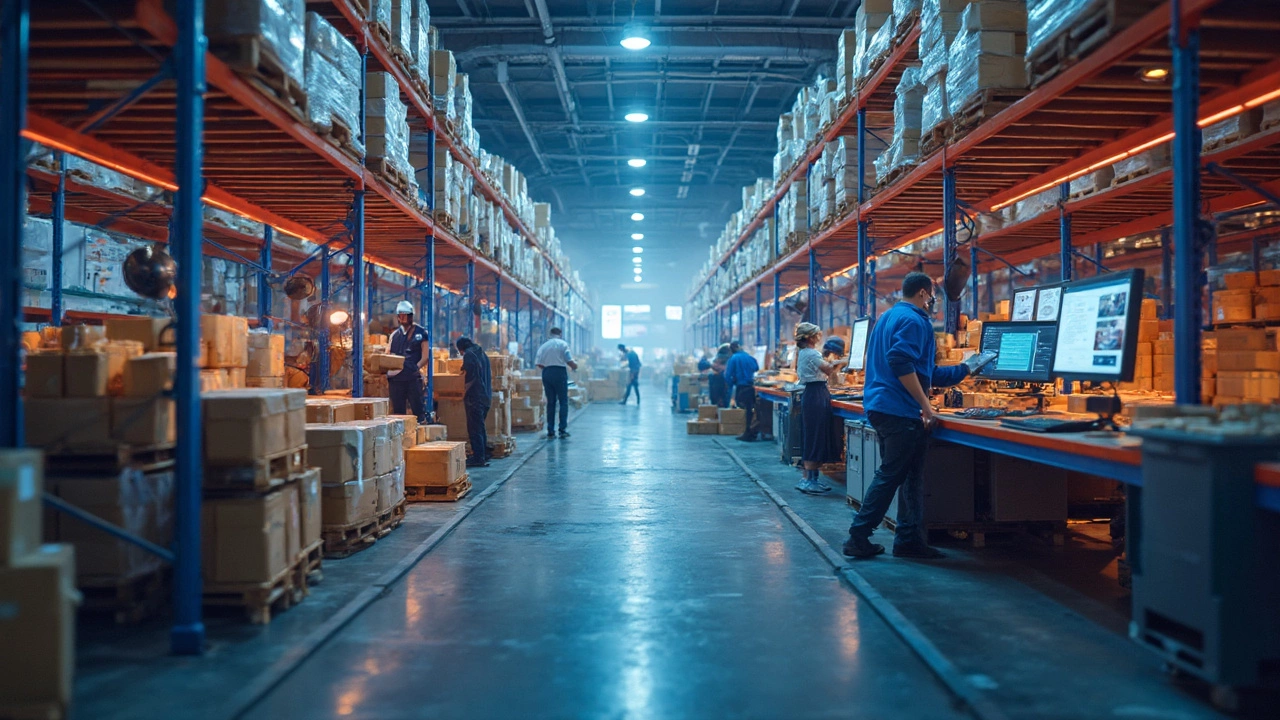Ever wonder how e-commerce logistics companies rake in the dough? It's not just about moving packages around—there's a whole lot more to it. Think technology, clever routing, and squeezing every drop of efficiency from their operations. With the online shopping boom showing no signs of slowing down, these businesses have gotten pretty savvy about turning a profit.
First up, cutting costs is a big part of the game. Imagine having a blueprint where each step saves a buck here and a buck there—that's what logistics companies do. They look at their supply chain from all angles to trim the fat and make everything run smoother.
- Understanding the E-commerce Boom
- Cutting Costs with Smart Strategies
- The Role of Technology and Innovation
- Importance of Last-Mile Delivery
- How Data and Analysis Drive Profits
Understanding the E-commerce Boom
It's like a whirlwind—how fast e-commerce has grown. Back in 2020, everyone suddenly shopped online like it was the most natural thing ever. Fast forward to 2025, and it's pretty much a daily activity. The convenience of clicking a button and having something land at your doorstep is too good to pass up.
So, what's fueling this e-commerce frenzy? A couple of things. First off, smartphones have become like that extra hand you never knew you needed. With everyone attached to their devices, shopping anytime and anywhere is just part of life. And let's not forget the role of social media; it turns browsing into an endless shopping spree.
All this growth means more packages zipping around, which is where *logistics* shine. They're the backbone, making sure every order, big or small, gets from the warehouse to your door without a hitch. Consumption has skyrocketed, partly thanks to improved online payment systems making transactions smoother than ever.
- E-commerce platforms are constantly pushing the envelope—expanding selections and using data to know what you're going to buy before you even do.
- *Logistics companies* are upping their game, using smart tech and automation to keep up. Robotic systems in warehouses and AI for route planning are pretty standard these days.
Here's a fun stat: by 2025, online shopping sales are expected to hit $7 trillion globally. That's a ton of products needing fast and efficient delivery, opening a goldmine for the *logistics* sector.
| Year | Global E-commerce Sales ($ Trillion) |
|---|---|
| 2020 | 4.2 |
| 2025 | 7.0 |
Cutting Costs with Smart Strategies
Cutting costs is where logistics businesses really flex their muscles. A big secret to their success lies in dodging unnecessary expenses and maximizing efficiency at every step.
First things first, optimizing the supply chain is crucial. E-commerce logistics companies analyze every detail to find the most cost-effective routes. It’s like playing chess, moving each piece strategically to save both time and money.
One common method is using a hub-and-spoke model, where packages are sent to central hubs before reaching their final destinations. This helps consolidate shipments, which means fewer trips and less fuel consumption. Less fuel used equals more profits.
Another smart move is negotiating with suppliers. The big players in the game use their buying power to get better deals on everything from packaging materials to transportation costs. It’s all about keeping overhead low without compromising on service quality.
Then, there’s tech. Oh boy, technology is a game changer here. Automated warehouses decrease the need for manpower, while sophisticated tracking systems keep tabs on packages in real-time. This reduces errors, which in turn keeps customer complaints—and associated costs—down.
Lastly, returns management is a huge factor. A streamlined returns process can significantly cut down reverse logistics costs, which is often overlooked by many newcomers in e-commerce logistics.
| Strategy | Benefit |
|---|---|
| Hub-and-Spoke Model | Reduces trips and fuel consumption |
| Supplier Negotiation | Lowered overhead expenses |
| Warehouse Automation | Decrease manpower requirements |
| Efficient Returns Management | Minimize reverse logistics costs |
These tactics don't just stop at slashing costs; they also boost profits and keep the logistics engines humming. In the crazy fast world of online shopping, staying ahead means always finding new ways to save and streamline.

The Role of Technology and Innovation
When it comes to e-commerce logistics, technology isn't just a nice-to-have—it’s a game-changer. Imagine the chaos of manually managing the movement of thousands of packages; it’s an absolute nightmare. That’s where tech steps in, making the process smooth and efficient.
First off, automation in warehouses is huge. Robots and conveyor systems sort and move items faster than any human could. This not only speeds up order fulfillment but also cuts down on errors. Plus, using technology like RFID tags and barcode scanners helps keep tabs on inventory levels and ensures everything is in the right place.
Then there are the predictive analytics tools that crunch customer data. These make life easier for logistics companies by forecasting demand. Knowing when the next shopping surge is coming lets them prepare and avoid getting caught off guard. And hey, less unused stock means saving money, which directly feeds into those nice profit margins.
Don't forget the power of route optimization software. By analyzing traffic patterns and delivery routes, these tools help fleets spend less on fuel and get goods to customers faster. A quicker last-mile delivery means happier customers, which is always good for business.
And we can’t talk about tech without mentioning drones and delivery bots. Although still not mainstream, these innovations are starting to make their presence felt, offering ultra-fast local deliveries in certain areas.
If you're curious about cold, hard data, check this out:
| Technology | Benefit | Impact |
|---|---|---|
| Automation | Speeds up processing | 25% faster order fulfillment |
| Predictive Analytics | Improves demand forecasting | 15% reduction in excess inventory |
| Route Optimization | Reduces fuel costs | 10% savings on logistics costs |
So, if you’re in the logistics game, embracing technology isn’t just an option—it’s crucial for turning a tidy profit.
Importance of Last-Mile Delivery
Last-mile delivery—it's a big deal in the world of e-commerce logistics. This is the final step in getting your package from the warehouse to your door. Sounds simple, but making this last bit of the journey smooth can be the difference between a happy customer and an angry one.
First things first, it's all about timing. With folks expecting faster shipments, especially because of the competition from the likes of Amazon Prime, last-mile delivery can make or break a sale. Companies that nail this step don't just meet expectations; they create loyal customers who keep coming back.
But there's more than just customer happiness on the line. Efficiency in last-mile delivery also means saving money. By optimizing routes and making delivery schedules smarter, companies can cut fuel costs and labor hours. It's about getting the most bang for their buck.
Technology plays a huge role here. Imagine delivery routes being mapped out in real time based on traffic and weather conditions. This isn't sci-fi—it's happening now. Many logistics companies are leveraging tech like GPS tracking and AI to make these decisions on the fly. It doesn’t just streamline operations; it ensures packages get where they need to be as fast as possible.
In fact, some companies are even using lockers and secure pickup points to simplify the process. This allows customers to collect their packages at a convenient time, reducing delivery failures when no one’s home to sign for a parcel.
Also, let's not forget the environmental factor. Fewer random deliveries mean fewer emissions. It's all about doing the right thing for the planet while keeping costs down—a win-win if you ask me.
All in all, mastering last-mile delivery is crucial for staying competitive in the bustling world of e-commerce. It's about blending tech, efficiency, and customer needs to make the journey from warehouse to home as seamless as possible.

How Data and Analysis Drive Profits
Alright, let's get into how logistics companies use data to make some serious cash. In e-commerce, data isn't just numbers—it's gold. These companies crunch all kinds of data to figure out how to get packages from warehouse to doorstep without a hitch.
First off, using data helps them optimize their routes. With the right tools, logistics firms can find the quickest, cheapest, and most efficient way to deliver goods. This not only saves money but also improves delivery times, which keeps customers happy— a double win.
Next, there's the whole inventory gig. By keeping an eye on sales patterns and stock levels, companies can make sure they aren’t stuck with stuff nobody wants or running out of what's selling hot. Smart inventory management is a big money saver and a revenue booster.
But it doesn't stop there. Data analytics gives insights into customer behaviors. Companies learn what people buy, when they buy it, and even how often. Using this info, they can offer personalized services and special deals, fostering customer loyalty and increasing sales.
And, here's a cool fact: some firms are using machine learning to predict demand. By looking at past trends and current data, they can forecast what products will be in demand and when, allowing them to prepare better and avoid unnecessary costs.
| Data Strategy | Benefit |
|---|---|
| Route Optimization | Reduced delivery costs and improved times |
| Inventory Management | Reduced stock holding costs and improved sales |
| Customer Insights | Enhanced customer satisfaction and loyalty |
| Demand Forecasting | Better resource allocation and reduced costs |
In short, by leveraging data, e-commerce logistics companies not only make operations smooth but also cut costs and increase profits. So, that box arriving faster at your door? It’s all part of the bigger money-making game.


